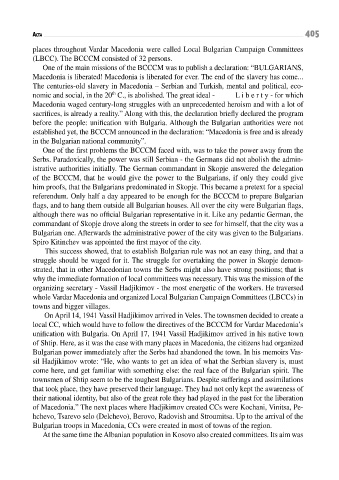Page 405 - Conflitti Militari e Popolazioni Civili - Tomo I
P. 405
405
aCta
places throughout Vardar Macedonia were called Local Bulgarian Campaign Committees
(LBCC). The BCCCM consisted of 32 persons.
One of the main missions of the BCCCM was to publish a declaration: “BULGARIANS,
Macedonia is liberated! Macedonia is liberated for ever. The end of the slavery has come...
The centuries-old slavery in Macedonia – Serbian and Turkish, mental and political, eco-
th
nomic and social, in the 20 C., is abolished. The great ideal - L i b e r t y - for which
Macedonia waged century-long struggles with an unprecedented heroism and with a lot of
sacrifices, is already a reality.” Along with this, the declaration briefly declared the program
before the people: unification with Bulgaria. Although the Bulgarian authorities were not
established yet, the BCCCM announced in the declaration: “Macedonia is free and is already
in the Bulgarian national community”.
One of the first problems the BCCCM faced with, was to take the power away from the
Serbs. Paradoxically, the power was still Serbian - the Germans did not abolish the admin-
istrative authorities initially. The German commandant in Skopje answered the delegation
of the BCCCM, that he would give the power to the Bulgarians, if only they could give
him proofs, that the Bulgarians predominated in Skopje. This became a pretext for a special
referendum. Only half a day appeared to be enough for the BCCCM to prepare Bulgarian
flags, and to hang them outside all Bulgarian houses. All over the city were Bulgarian flags,
although there was no official Bulgarian representative in it. Like any pedantic German, the
commandant of Skopje drove along the streets in order to see for himself, that the city was a
Bulgarian one. Afterwards the administrative power of the city was given to the Bulgarians.
Spiro Kitinchev was appointed the first mayor of the city.
This success showed, that to establish Bulgarian rule was not an easy thing, and that a
struggle should be waged for it. The struggle for overtaking the power in Skopje demon-
strated, that in other Macedonian towns the Serbs might also have strong positions; that is
why the immediate formation of local committees was necessary. This was the mission of the
organizing secretary - Vassil Hadjikimov - the most energetic of the workers. He traversed
whole Vardar Macedonia and organized Local Bulgarian Campaign Committees (LBCCs) in
towns and bigger villages.
On April 14, 1941 Vassil Hadjikimov arrived in Veles. The townsmen decided to create a
local CC, which would have to follow the directives of the BCCCM for Vardar Macedonia’s
unification with Bulgaria. On April 17, 1941 Vassil Hadjikimov arrived in his native town
of Shtip. Here, as it was the case with many places in Macedonia, the citizens had organized
Bulgarian power immediately after the Serbs had abandoned the town. In his memoirs Vas-
sil Hadjikimov wrote: “He, who wants to get an idea of what the Serbian slavery is, must
come here, and get familiar with something else: the real face of the Bulgarian spirit. The
townsmen of Shtip seem to be the toughest Bulgarians. Despite sufferings and assimilations
that took place, they have preserved their language. They had not only kept the awareness of
their national identity, but also of the great role they had played in the past for the liberation
of Macedonia.” The next places where Hadjikimov created CCs were Kochani, Vinitsa, Pe-
hchevo, Tsarevo selo (Delchevo), Berovo, Radovish and Stroumitsa. Up to the arrival of the
Bulgarian troops in Macedonia, CCs were created in most of towns of the region.
at the same time the albanian population in Kosovo also created committees. its aim was

